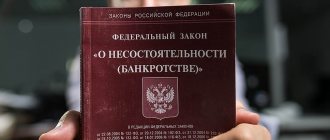Calculation of creditor penalties when submitting an application to the register
We are preparing an application to include us in the register of creditors.
A supervision procedure (bankruptcy) was introduced in relation to the debtor by a court ruling. According to the agreement, there is a principal amount of debt, and also provides for penalties for late payment (delivery agreement). Until what day can penalties be calculated? Before the date of the court's decision on the monitoring procedure or before our date of filing the application? Before submitting the application, it is possible to calculate penalties under the supply agreement, since the organization’s activities have not been terminated, only a monitoring procedure has been introduced. You can be guided by the plenum of the Supreme Arbitration Court of the Russian Federation 2013 88. The company must fulfill its obligations if bankruptcy proceedings have been initiated.
Thank you, you helped me a lot!
Before the application submission date, calculate late fees under the supply agreement.
In connection with issues arising in judicial practice related to the calculation and payment of interest on claims of creditors in bankruptcy, the Plenum of the Supreme Arbitration Court of the Russian Federation, guided by Article 13 of the Federal Constitutional Law of April 28, 1995 N 1-FKZ “On Arbitration Courts in the Russian Federation” , decides to give the following clarifications to the arbitration courts.
1. Based on paragraph 1 of Article 4 and paragraph 1 of Article 5 of the Federal Law of October 26, 2002 N 127-FZ “On Insolvency (Bankruptcy)” (hereinafter referred to as the Bankruptcy Law, the Law), if the main claim of the creditor against the debtor arose before the initiation of the case about bankruptcy, then all additional claims associated with it have the same legal regime during bankruptcy, that is, they are not current and are subject to inclusion in the register of creditors’ claims.
For these purposes, the basic requirements are understood as requirements for the repayment of the loan amount (Article 810 of the Civil Code of the Russian Federation; hereinafter - the Civil Code of the Russian Federation), for payment of the price of goods, work or services (Articles 485 and 709 of the Civil Code of the Russian Federation), the amount of tax or fee, etc. P.
The additional requirements mentioned include, in particular, requirements for the payment of interest on the loan amount (Article 809 of the Civil Code of the Russian Federation) or for the unlawful use of other people's funds (Article 395 of the Civil Code of the Russian Federation), penalties in the form of penalties (Article 330 of the Civil Code of the Russian Federation), late fees payment of a tax or fee (Article 75 of the Tax Code of the Russian Federation), etc. (hereinafter referred to as interest) and the payment of penalties in the form of a fine.
2. If, by a judicial act confirming the claims of the creditor who applied to declare the debtor bankrupt (applicant), interest was collected on the date of actual execution of the judicial act, then on the basis of the first paragraph of paragraph 1 of Article 4 of the Bankruptcy Law, the register of creditors’ claims based on the results of the verification This application includes the amount of these interests, calculated on the date of filing the application to the court to declare the debtor bankrupt, since in this case this entire amount is confirmed by a judicial act.
For the purposes of applying the first paragraph of paragraph 1 of Article 4 of the Bankruptcy Law, the date of filing the application is understood as the date of its receipt by the court, and not the date of the court’s ruling on its acceptance.
If, by a judicial act, interest is collected as of a certain date in a specific amount, then only this amount of interest collected by the court is included in the register of creditors' claims, and interest for the period from the mentioned date to the date of filing the application for declaring the debtor bankrupt, since they are not confirmed by a judicial act , cannot be included in the register at the stage of checking the validity of this application.
Taking into account the requirements of paragraphs 1 and 2 of Article 3 and paragraph 2 of Article 4 of the Bankruptcy Law, when determining the total amount of the applicant’s claims for the purposes of paragraph 2 of Article 33 of the Law, the entire amount of interest calculated according to the specified rules is taken into account; a three-month delay is not required for the main claim, but for interest.
Interest on the claim on which the application for declaring the debtor bankrupt was based, for the period from the date on which they were established upon the introduction of supervision until the date of introduction of supervision, can be presented by the applicant in a bankruptcy case in the general manner according to the rules of Articles 71 or 100 of the Law .
Bankruptcy procedure through court
The process of recognizing the insolvency of legal entities and individuals begins from the moment of filing the corresponding application with the arbitration court at the location of the debtor (Article 224 of the Arbitration Procedure Code of the Russian Federation). This can be done by creditors, authorized bodies, as well as other interested parties, for example, a former employee with demands for payment of severance pay. In addition, a legal dispute about insolvency can begin upon an application from the debtor himself (Article 7 127-FZ).
How does bankruptcy court work for legal entities - the main stages
The general provisions of the Arbitration Procedure Code of the Russian Federation apply to the arbitration process in this category of cases, but taking into account the features listed in the Federal Law “On Insolvency (Bankruptcy)”. The consideration period is seven months from the date of receipt of the application (Article 51 127-FZ). In practice, we will encounter classic litigation in the following order:
- Submitting an application (Chapter 13 of the Arbitration Procedure Code of the Russian Federation), which is mentioned above, the court will issue a ruling on its acceptance within five days (Article 47 127-FZ).
- Preparation for the trial (Chapter 14 of the Arbitration Procedure Code of the Russian Federation).
- Consideration of the case (Chapter 19 of the Arbitration Procedure Code of the Russian Federation).
- Issuance of rulings by the court (Chapter 21 of the Arbitration Procedure Code of the Russian Federation), for example, on the introduction of a monitoring procedure or on the appointment of a bankruptcy trustee.
- Decision making (Chapter 20 of the Arbitration Procedure Code of the Russian Federation).
If you disagree with the court decision, you can appeal it within a month (Article 259 of the Arbitration Procedure Code of the Russian Federation). Further, it can be changed or canceled by a ruling of the appellate court. In addition, the participants in the case retain the right to cassation appeal for two months.
Let us recall that, depending on the circumstances, several different procedures may be applied to the debtor in the rulings of the arbitration court:
- surveillance - used to preserve property and analyze the condition of the company against which a lawsuit has been filed;
- financial recovery - used to restore the debtor’s solvency and is accompanied by satisfaction of creditors’ claims according to the approved schedule;
- external management - consists of transferring all powers to manage the company to a manager appointed by the court;
- bankruptcy proceedings - a final procedure involving the liquidation of an organization and the sale of the debtor’s property in order to proportionately repay all debts in order of priority;
- a settlement agreement is another acceptable outcome of the case, when creditors make concessions to the debtor and find a mutually beneficial solution to the current situation.
Combinations of procedures differ depending on the nature of the organization's activities. According to the classic scenario, first a court ruling introduces surveillance, which is supervised by a temporary (arbitration) manager, and then, after studying the financial condition of the debtor, other measures can be applied. In addition, there is a simplified version of bankruptcy, when the insolvency of a legal entity is obvious, and the process immediately proceeds to the stage of bankruptcy proceedings.
Bankruptcy court for individuals - differences
For citizens and individual entrepreneurs, the judicial practice of bankruptcy is identical, but with the exception of the procedures applied (Article 213.2 127-FZ):
- Debt restructuring is a plan for repaying obligations to creditors; it is introduced by the court only in relation to individuals who have income and also satisfy a number of conditions listed in Art. 213.13 127-FZ;
- sale of property - sale of all things and assets belonging to a citizen, the procedure is carried out by a financial manager who is appointed by the court and acts on behalf of the bankrupt debtor (Article 213.25 127-FZ);
- settlement agreement - is the basis for termination of proceedings as a result of finding a mutually beneficial solution between the creditors and the defendant.
Below is a video with brief instructions on the procedure for individuals in bankruptcy.
The time limit for filing and consideration of a complaint on appeal is limited to one month from the date of the decision, as for legal entities.
Power of attorney and legal expenses
Financial questions regarding the costs of all bankruptcy legal proceedings are common. There can be two scenarios here:
- the requirements for recognition of insolvency are justified - in this case, the entire burden, in particular, the payment of the state duty, falls on the debtor’s property (if it is not enough, then the uncovered part will be paid by the applicants);
- refusal to proceed in the case - with this result, all costs are distributed among the applicants in proportion to the amounts they requested.
A power of attorney in a bankruptcy case is mandatory when planning to avoid personal participation in legal disputes (Article 36 127-FZ); you can find its form for individuals here. Let us immediately note that the content of this document differs depending on the circumstances of the case, so in the above example there will not be all the necessary powers for a particular situation.
Accrual of interest by the bank on a loan when calculating income tax
According to paragraph 1 of Art. 4 of the Federal Law No. “On Insolvency (Bankruptcy)” (hereinafter referred to as Law No.), the composition and amount of monetary obligations and obligatory payments are determined as of the date of filing an application to the arbitration court to declare the debtor bankrupt, unless otherwise provided by this Federal Law.
In accordance with paragraph 1 of Art. 126 of Law No. from the date of the arbitration court’s decision to declare the debtor bankrupt and to open bankruptcy proceedings, in particular, the accrual of interest, penalties (fines, penalties) and other sanctions for non-fulfillment or improper fulfillment of monetary obligations and obligatory payments, with the exception of current payments, ceases , as well as interest provided for in Art. 126 of Law no.
Based on paragraph 1 of Art. 248 of the Tax Code of the Russian Federation, income for the purposes of Chapter 25 of the Tax Code of the Russian Federation includes income from the sale of goods (work, services) and property rights (hereinafter referred to as income from sales), non-operating income.
As stated in paragraph 6 of Art. 250 of the Tax Code of the Russian Federation, non-operating income is recognized as income not specified in Art. 249 of the Tax Code of the Russian Federation.
Non-operating income of a taxpayer is recognized, in particular, as income in the form of interest received under loan, credit, bank account, bank deposit agreements, as well as on securities and other debt obligations (the specifics of determining bank income in the form of interest are established by Article 290 of the Tax Code of the Russian Federation) .
By virtue of paragraph 1 of Art. 269 of the Tax Code of the Russian Federation, debt obligations are understood as credits, commodity and commercial loans, loans, bank deposits, bank accounts or other borrowings, regardless of the form of their execution.
Based on clauses 1 item 2 art. 290 of the Tax Code of the Russian Federation, bank income includes, in particular, income from banking activities in the form of interest from the placement by the bank in its own name and at its own expense of funds, provision of loans and borrowings.
According to paragraphs. 2 clause 4 art. 271 of the Tax Code of the Russian Federation for non-operating income, the date of receipt of income is the date of receipt of funds to the taxpayer’s current account (cash), in particular, for income in the form of interest accrued on the amount of claims of the bankruptcy creditor in accordance with the legislation on insolvency (bankruptcy).
It is necessary to note the position of the Plenum of the Supreme Arbitration Court of the Russian Federation. According to paragraph 4 of the Resolution of the Plenum of the Supreme Arbitration Court of the Russian Federation dated No. 88 “On the accrual and payment of interest on the claims of creditors in bankruptcy” during the monitoring procedure for the claims of creditors that arose before the initiation of bankruptcy proceedings (both declared in the monitoring procedure and not declared in it) by analogy with paragraph 10, clause 1, art. 81, paragraph 3, paragraph 2, art. 95 and paragraph 3 of paragraph 1 of Art. 126 of Law No. interest payable under the terms of the obligation, as well as sanctions, are not accrued. Instead, for the amount of the main claim, by analogy with clause 2 of Art. 81, paragraph 4, paragraph 2, art. 95 and clause 2.1 of Art. 126 of Law No. from the date of introduction of supervision until the date of introduction of the next bankruptcy procedure, interest is accrued in the amount of the refinancing rate established by the Bank of Russia on the date of introduction of supervision.
On the accrual of interest on debt obligations in the event of bankruptcy of the debtor
Home | Legislation | Acts of the Ministry of Finance of the Russian Federation and its structural divisions on issues related to bankruptcy | On the accrual of interest on debt obligations in the event of bankruptcy of the debtor
Letter of the Department of Tax and Customs Tariff Policy of the Ministry of Finance of the Russian Federation dated June 14, 2011 N 03-03-06/1/343
Question: The agency, which refinances mortgage-secured obligations as its main activity, requests clarification of the procedure for reflecting interest income on mortgage-secured obligations for tax and accounting purposes in the event of bankruptcy of a debtor - an individual entrepreneur.
In accordance with paragraph 1 of Article 126 of Federal Law No. 127 of October 26, 2002 “On Insolvency (Bankruptcy)” (hereinafter referred to as the Bankruptcy Law), from the date of the arbitration court’s decision to declare the debtor bankrupt and to open bankruptcy proceedings:
— the accrual of interest, penalties (fines, penalties) and other penalties for non-fulfillment or improper fulfillment of monetary obligations and obligatory payments is stopped, with the exception of current payments, as well as interest provided for in this article.
At the same time, clause 2.1 of this article of the Bankruptcy Law provides for the accrual of interest on the amount of claims of the bankruptcy creditor in the amount of the refinancing rate established by the Bank of Russia on the date of opening of bankruptcy proceedings until the date of repayment by the debtor of the claims of this bankruptcy creditor. The amount of the specified interest may be reduced by agreement of the bankruptcy trustee and the bankruptcy creditor.
It should be noted that the Agency is a creditor of individuals for obligations not related to the latter’s entrepreneurial activities (loans and credits for the purchase of residential premises). In accordance with paragraph 18 of the Resolution of the Plenum of the Supreme Arbitration Court of the Russian Federation dated July 23, 2009 N 58, if the pledge of the debtor’s property secures claims not related to the debtor’s business activities, these claims of the secured creditor are preserved after completion of the bankruptcy procedure if the secured creditor did not participate in the bankruptcy proceedings as a bankruptcy creditor. Thus, if the claims of the secured creditor for obligations not related to the debtor’s business activities are not included by the arbitration court in the register of creditors’ claims, such claims are preserved and can be presented after the completion of the debtor’s bankruptcy procedure.
Based on the above, and also taking into account that the credit agreement (loan agreement) does not terminate from the date the debtor is declared bankrupt and bankruptcy proceedings are introduced against him, the Agency asks for clarification of the following issues for tax purposes:
1. Does the provision of paragraph 1 of Article 126 of the Bankruptcy Law apply to interest on the use of a credit or loan (Articles 809, 819 of the Civil Code of the Russian Federation)?
2. Does the creditor have the right to stop accruing interest for the use of a credit or loan from the date the debtor is declared bankrupt if the creditor’s claims are included by the arbitration court in the register of creditors’ claims?
3. Does the creditor have the right to stop accruing interest for the use of a credit or loan from the date the debtor is declared bankrupt if the creditor’s claims are not related to the debtor’s business activities and are not included by the arbitration court in the register of creditors’ claims (clause 18 of the Resolution of the Plenum of the Supreme Arbitration Court of the Russian Federation dated July 23 .2009 N 58)?
4. Is declaring a debtor bankrupt a basis for terminating the obligation secured by a mortgage?
5. From what moment are the penalties established by the contract recognized as non-operating income (Article 250 of the Tax Code of the Russian Federation) in the event of one of the bankruptcy procedures being introduced against the debtor?
6. At what point during the bankruptcy procedure does the bankruptcy creditor and the bankruptcy trustee have the right to enter into an agreement to reduce the amount of interest established by clause 2.1 of Art. 126 of the Bankruptcy Law? Do the bankruptcy creditor and the bankruptcy trustee have the right to enter into an agreement on the non-accrual of interest established by clause 2.1 of Art. 126 of the Bankruptcy Law? How, for tax purposes, should interest accrued in accordance with clause 2.1 of Art. 126 of the Bankruptcy Law, but not paid to the bankruptcy creditor due to the insufficiency of the debtor’s property, taking into account clause 8 of Art. 142 of the Bankruptcy Law?
Answer: The Department of Tax and Customs Tariff Policy has reviewed the letter regarding the procedure for calculating interest on debt obligations during the debtor’s bankruptcy proceedings and reports the following.
In accordance with clause 11.4 of the Regulations of the Ministry of Finance of the Russian Federation, approved by order of the Ministry of Finance of the Russian Federation dated March 23, 2005 N 45n, the Ministry, unless otherwise established by law, does not consider on the merits appeals for clarification (interpretation of norms, terms and concepts) of the legislation of the Russian Federation Federation and the practice of its application, on the practice of applying regulatory legal acts of the Ministry, on conducting an examination of contracts, constituent and other documents of organizations, on assessing specific economic situations
Clause 1 of Article 34.2 of the Tax Code of the Russian Federation (hereinafter referred to as the Tax Code of the Russian Federation) provides that the Ministry of Finance of the Russian Federation provides written explanations on the application of the legislation of the Russian Federation on taxes and fees.
In this regard, we inform you that income in the form of interest received under loan agreements, credit, bank account, bank deposit, as well as on securities and other debt obligations, are taken into account as part of non-operating income on the basis of paragraph 6 of Article 250 of the Tax Code of the Russian Federation.
In accordance with paragraph 6 of Article 271 of the Tax Code of the Russian Federation, when applying the accrual method, income in the form of interest is recognized as received and is included in the corresponding income at the end of the month of the corresponding reporting period, regardless of the actual receipt of funds or other property in payment for them.
Paragraph 1 of Article 269 of the Tax Code of the Russian Federation provides that for the purposes of Chapter 25 of the Tax Code of the Russian Federation, debt obligations mean loans, commodity and commercial loans, loans, bank deposits, bank accounts or other borrowings, regardless of the form of their execution.
Thus, the basis for accrual of income in the form of interest in tax accounting is a valid debt obligation, the terms of which provide for the payment of interest.
The calculation of interest on the obligations of a debtor against whom bankruptcy proceedings have been initiated is carried out taking into account the specifics established by Federal Law No. 127-FZ of October 26, 2002 “On Insolvency (Bankruptcy)”.
At the same time, issues related to the procedure for calculating interest on the debt obligations of a debtor in respect of whom bankruptcy proceedings have been initiated are regulated by the said Federal Law and do not fall within the competence of the Department.
Deputy Director of the Department S.V. Razgulin
The principle of accrual and calculation of moratorium interest in bankruptcy cases
The bankruptcy procedure itself is not the simplest, but when it comes to the nuances, people who are encountering the procedure for the first time cannot say anything. The same applies to such a topic as moratorium interest. That is why it is so important to understand one of the most complex issues of bankruptcy - what it is and what its role is in bankruptcy cases. But even this is not enough, because it is important to determine how they are calculated. It is with accrual that the most problems and questions arise.

Our articles talk about typical ways to resolve legal issues, but each case is unique. If you want to find out how to solve your specific problem, please contact the online consultant form on the right →
It's fast and free!
Or call us by phone (24/7):
If you want to find out how to solve your particular problem, call us by phone. It's fast and free!
“Review of judicial practice on issues related to the participation of authorized bodies in bankruptcy cases and bankruptcy procedures applied in these cases”; approved by the Presidium of the Supreme Court of the Russian Federation on December 20, 2016 (extract):
Qualification and establishment of requirements for mandatory payments in a bankruptcy case
9. Penalties and fines accrued to the debtor for failure to transfer to the budget the personal income tax withheld when paying income before the initiation of bankruptcy proceedings are taken into account separately as part of third-priority payments.
As part of the debtor's bankruptcy case, the authorized body applied to the arbitration court with an application to include in the register of creditors' claims debt for mandatory payments, including amounts of personal income tax that were withheld by the debtor before the institution of bankruptcy proceedings, but were not transferred to the budget , as well as penalties accrued on these amounts.
By the ruling of the court of first instance, left unchanged by the court of appeal and the district court, the claims of the authorized body in terms of the amounts of personal income tax and penalties related to them were included in the second stage of the register of creditors' claims.
Judicial acts are motivated by the fact that the requirement to pay penalties on personal income tax arose from the failure of the debtor to fulfill the main obligation of the debtor to transfer this tax to the budget, and therefore follows its fate and should be taken into account as part of the second stage of the register of creditors' claims.
The Judicial Collegium for Economic Disputes of the Supreme Court of the Russian Federation did not agree with the conclusions of the courts regarding the determination of the order of satisfaction of claims for penalties accrued in relation to personal income tax, indicating the following.
By allowing a delay in fulfilling the duty of a tax agent, the debtor commits his own offense, liability for which is provided for by the Tax Code of the Russian Federation. Therefore, the requirement of the authorized body to include in the register of relevant financial sanctions (fines imposed under Article 123 of the Tax Code of the Russian Federation and penalties accrued in accordance with Article 75 of the Tax Code of the Russian Federation) is reflected in the register of creditors’ claims based on the general rules on the order of satisfaction of mandatory payments: these financial sanctions are subject to satisfaction as part of the third priority after repayment of the principal amount of debt and interest due (clause 3 of Article 137 of the Bankruptcy Law).
Under such circumstances, the qualification of the amount of penalties for personal income tax as a claim subject to inclusion in the second stage of the register of creditors' claims is erroneous.
What is moratorium interest?
Before being declared bankrupt, organizations can receive a grace period - a period during which they can try to pay off their debts. And not such radical measures as declaring oneself bankrupt and closing.
During the period when the company is trying to cope with debts, creditors should relax the conditions for repayment of debt. For example, offer not to pay part of the debt. True, in this case it is not the debtor who will suffer, but the creditor, which is also not welcome. We have to look for an alternative.
So we come to what moratorium interest is in bankruptcy. This is the name for interest payments that are accrued to the creditor during the official bankruptcy procedure. They are an alternative replacement for the fines that the creditor is entitled to from the debtor for late payments on loans.
Simply put, this is the name for the amount that is charged to the lender not for the loan that he provided, but for the debt that remains from the principal debt. This is a replacement for penalties, fines and other sanctions that the debtor would have to pay if he had not declared his bankruptcy on time.

How and when this debt is repaid is determined by the arbitration court (arbitration manager). A court order is not needed for this. You need to pay off the MP first.
Moratorium interest
are included in the interest at the request of the secured creditor, repaid to a greater extent before the claims of other creditors. 1. Moratorium interest is accrued only on the amount of the main claims; FREE CONSULTATIONS ARE AVAILABLE TO ALL CITIZENS AT THE SPECIFIED TELEPHONE NUMBERS OR IN CHAT MODE The accrued moratorium interest is not included in the register of creditors' claims and is not taken into account when determining the amount belonging to the bankruptcy creditor, the authorized body at meetings of creditors.
It is important that, according to paragraph.
12 Resolution of the Plenum of the Supreme Arbitration Court of the Russian Federation of December 6, 2013
No. 88, the indicated provisions are used when courts consider only such bankruptcy cases for which the first bankruptcy procedure was introduced after its publication. It must be emphasized that this resolution of the Plenum of the Supreme Arbitration Court of the Russian Federation radically changed the approach according to which the amount of interest claims of creditors was determined as of the date of the bankruptcy procedure in which they were declared. According to the Resolution of the Thirteenth Arbitration Court of Appeal dated November 27, 2014 in case No. A56-50686/2012, it is indicated that at the same time the appeal tribunal recognizes as incorrect the conclusion of the court of first instance that the Company does not have a preemptive right to receive moratorium interest in the amount of 7,834 RUR 398.81
The procedure for dispersing money received from the sale of the collateral is defined in Article 138 of the Bankruptcy Law. 11. To recognize as invalid paragraphs 1st - 3rd pt 4 of the resolution of the Plenum of the Supreme Arbitration Court of the Russian Federation dated July 23, 2009 No. 63
“On current payments for foreign currency obligations in a bankruptcy case”
. For these purposes, the basic requirements are understood as requirements for the repayment of the loan amount (Article 810 of the Civil Code of the Russian Federation; hereinafter referred to as the Civil Code of the Russian Federation), payment of the price of a product, work or service (Articles 485 and 709 of the Civil Code of the Russian Federation), the amount of tax or fee, etc. .P.
The designated moratorium interest for the period of observation and other procedures is not included in the register of creditors' claims and is not taken into account when determining the amount belonging to the creditor at meetings of creditors.
Features of the interest calculation procedure
Moratorium interest in bankruptcy is a fixed amount. Its size depends on the refinancing rate. Moreover, the one assigned by the bank at the time of implementation of each procedure.
When interest is paid, the amount that meets the basic requirements is credited. In this case, this amount will not be included in the register of creditors, but will be accrued along with the “body” of the loan. She acts as a guarantor that the debtor will do everything possible to repay the debt, even if proceedings have begun.
Resolutions of the Plenum of the Supreme Arbitration Court of the Russian Federation
If the debt repayment schedule approved by the meeting of creditors during financial rehabilitation or the external management plan approved by the meeting of creditors provides for incomplete repayment of claims included in the register (for example, without repayment of moratorium interest), then after the termination of bankruptcy proceedings in connection with the repayment of claims on the terms specified schedule or plan, creditors may, in a general action, demand from the debtor payment of the remaining unpaid moratorium interest, unless otherwise provided by the schedule or plan; otherwise, it may be provided, in particular, both the absence of the right to demand additional payment of such interest, and the right to demand additional payment not of moratorium interest, but of interest subject to accrual under the terms of the obligation.
We recommend reading: Lease agreement for a summer cottage with a house
Taking into account the requirements of paragraphs 1 and 2 of Article 3 and paragraph 2 of Article 4 of the Bankruptcy Law, when determining the total amount of the applicant’s claims for the purposes of paragraph 2 of Article 33 of the Law, the entire amount of interest calculated according to the specified rules is taken into account; a three-month delay is not required for the main claim, but for interest.
Formula for calculating moratorium interest
A special formula is used to calculate moratorium interest. It helps to prevent unnecessary insinuations on the part of both debtors and creditors. Therefore, there is no room left for fraud.
It uses the Central Bank's refinancing interest rate as a basis. And not the most profitable one, but the one that was relevant at the time of the calculations.
For example, consider the formula that is used when calculating rates in rubles:
Naturally, for most people, how to do the calculation remains a mystery. Even if you have a formula, to understand it, you need to figure out what each value means:
- Рд – amount of the principal debt;
- SR – refinancing rate;
- T – the period during which moratorium payments will be made;
- 365 – days of the year;
- MP is the amount that this formula is looking for.

But loans are issued with equal frequency not only in ruble equivalent. Often, debtors have drawn up foreign currency loan agreements, and now they cannot pay them off. Moreover, this applies to both individuals and legal entities.
In this case, you can use a slightly different formula:
To convert the result into the desired form, simply multiply the resulting amount by 100%. This method is suitable for any currency in which borrowed funds were taken.
In what cases are moratorium interest lifted?
Accrual can be stopped in the following cases:
- when the entire debt is paid - it does not matter at what stage of bankruptcy this happens, even if in bankruptcy proceedings;
- if the complete insolvency of the organization is officially recognized, the debtor will be declared bankrupt;
That is, there are only two ways out. If the debtor pays off the debt in full, which is quite possible with proper management. Or if he cannot pay anything at all due to complete financial insolvency. In the latter case, all his property is sold off, and there is simply nothing to repay the debt from.
Legal problems of calculating moratorium interest in
FREE CONSULTATIONS ARE AVAILABLE TO ALL CITIZENS AT THE SPECIFIED PHONE NUMBERS OR VIA CHAT MODE
‒ the date of the arbitration tribunal’s ruling on the commencement of settlements with creditors according to the claims of creditors of each priority (intended for external management).
‒ the date of the decision to declare the debtor insolvent (bankrupt) and to open bankruptcy proceedings if repayment has not been made (intended for financial recovery and external management);
Reflection of moratorium interest in the creditor’s accounting
One of the main rules for receiving compensation is its correct inclusion in the financial statements. But how to record everything in this reporting? MP can be counted as “Other income”.

Taking this into account, you can record them in accounting documentation as follows:
- in the first section called “Income”;
- in the seventh section under the heading “Other income”;
- in the first subsection under the heading “Penalties, fines and penalties.”
Following these simple rules will help you avoid difficulties in reporting. There will be no confusion.
Moratorium interest is insurance for creditors when their client begins bankruptcy proceedings and therefore cannot pay as much as needed. But debtors usually cannot pay their debts. MP makes payments more accessible to debtors, and creditors receive at least something, even if not in full. Moreover, payments will continue until everything is paid or until the debtor’s assets are sold.
Our articles talk about typical ways to resolve legal issues, but each case is unique. If you want to find out how to solve your particular problem, please contact the online consultant form.
It's fast and free!
Or call us by phone (24/7):
If you want to find out how to solve your particular problem, call us by phone. It's fast and free!
What is moratorium interest in bankruptcy?
The process of declaring insolvency is characterized by legally established nuances. However, double interpretation of legal norms by both parties is fraught with the emergence of conflict situations. One of the “problematic” issues here is moratorium interest in bankruptcy. Let's look at the details of the interpretation and application of this term.
Dear readers! Our articles talk about typical ways to resolve legal issues, but each case is unique.
If you want to find out how to solve your particular problem, please contact the online consultant form on the right or call +7 8
It's fast and free!
Basic information
Since the procedure under consideration allows for a temporary ban on creditors when calculating interest payments on the amount of arrears, the defendant in the case receives a temporary respite and a chance for the company’s financial recovery.
However, the legislation guarantees the protection of the rights of both parties to the conflict . For this reason, legal norms say that while the moratorium is in effect, interest is accrued on the amount of claims presented by creditors.

In such circumstances, these payments do not include previously calculated debt parameters - payments are accrued only on the “body” of the arrears. These funds are called moratorium interest in bankruptcy proceedings.
The legal interpretation of the term is given by Resolution No. 88 of the Supreme Arbitration Court of the Russian Federation, issued in 2013. It says here that these payments compensate for the debtor’s use of borrowed resources from others.
Attention ! Federal Law No. 296, issued in 2008, established the right to use such a scheme when conducting bankruptcy proceedings.
As for the standards that regulate the procedure for calculating and paying interest, it is appropriate to refer to Art. 81, art. 95 and Art. 126 of the Law “On Bankruptcy”.
It is also said here that when calculating the exact figure, the basis is the Central Bank refinancing rate in effect at the time the procedure is applied. Accordingly, interest on the use of other people's funds in bankruptcy actually replaces fines.
Peculiarities
When bankruptcy proceedings are initiated, the accrual of contractual payments is automatically suspended. At the same time, the value under consideration here acts as a compensatory mechanism for protecting the interests of creditors.
Moreover, the legislation forces the plaintiff to include the specified amounts in the list of claims. Accordingly, repayment of such obligations becomes a priority for the debtor.
The specified payments during the observation stage are not included in the list specified in the register of creditors' claims . This amount is not recalculated if separate accompanying amounts arise in the case.
To calculate this parameter, a special formula is used, which will be discussed below. In addition, the law requires compliance with certain rules when accounting for these payments.
Determining the period
An important task for the correct calculation of the required amount is the correct clarification of the timing when interest is likely to accrue on creditors’ claims. In such situations, certain rules apply.
Moratorium interest
Accordingly, interest on the use of other people's funds in bankruptcy actually replaces fines.
When bankruptcy proceedings are initiated, the accrual of contractual payments is automatically suspended.
At the same time, the value under consideration here acts as a compensatory mechanism for protecting the interests of creditors. Moreover, the legislation forces the plaintiff to include the specified amounts in the list of claims. Accordingly, repayment of such obligations becomes a priority for the debtor.
The specified payments during the observation stage are not included in the list specified in the register of creditors' claims. This amount is not recalculated if separate accompanying amounts arise in the case. To calculate this parameter, a special formula is used, which will be discussed below.
We recommend reading: Is it possible to have dual citizenship in Belarus?
In addition, the law requires compliance with certain rules when accounting for these payments. An important task for the correct calculation of the required amount is the correct clarification of the timing when interest is likely to accrue on creditors’ claims.
In such situations, certain rules apply. The starting point here is the launch date of the established process stage. Moreover, the accrual of the payments in question ends with the repayment of the lenders’ claims in case of bankruptcy at any stage.
Another condition that makes it possible to stop the growth of moratorium sanctions involves a court decision declaring the debtor bankrupt. In this situation, the rule works at the stage of rehabilitation of the enterprise or during the work of an external manager.
The last condition here is the Arbitration's determination to start the next settlements with the plaintiffs in the case. This point applies at the stage of managing a company from the outside. The prerogative of accrual and control of such payments belongs to the arbitration manager. Let's look at the question of who sets the moratorium interest.
In this situation, the legislation does not provide clear answers.
Judicial practice shows that in such circumstances, demands for payment of these payments are included in the application for determining the financial responsibilities of the defendant.
At the same stage, the register is formed.
Accrual procedure
Let's look at the question of who sets the moratorium percentage. In this situation, the legislation does not provide clear answers.
Judicial practice shows that in such circumstances, demands for payment of these payments are included in the application for determining the financial responsibilities of the defendant.
At the same stage, the register is formed. However, there is a special nuance here.
According to the Resolution of the Supreme Arbitration Court No. 60, fine payments that accumulate during the stages of recognizing insolvency are assigned by the arbitration manager.
Accordingly, such funds are repaid according to a specially approved scheme and are not included in the debt registers.
A judicial act on the accrual of such payments is not required.
Important ! Actions related to the calculation and control of repayment of these payments are the exclusive prerogative of the arbitration attorney.
Moreover, the composition and value of the claims under consideration are determined as of the date of introduction of the observation. This point relieves the plaintiff of the need to choose the stage at which it is appropriate to impose additional financial sanctions.
In addition, this procedure guarantees a stable amount of fines imposed for payment. Previously, the amount of such payments was determined by the stage of the process at which such requirements were included.
Rights of DDU participants
When a construction company goes bankrupt, shareholders are in a more advantageous position than other creditors. The legislation gives persons who bought apartments during the construction phase of a house the right to choose between returning the money that was invested in the construction of a residential building or an apartment, while all other creditors can rely solely on payments in cash.
The decision to make a financial claim (refund of money) or a requirement to transfer a property (apartment) is made by the participants of the DDU independently. In addition, in addition to the return of the principal debt, the law provides for compensation for moral damage and a penalty in the event of bankruptcy of the developer, which the shareholder can recover from the construction company.
Citizens who are clients of a bankrupt developer can include their claims in:
- a general register of creditors' claims - if the participant in the DDU intends to receive monetary compensation;
- register of requirements for the transfer of residential premises - if a participant in a residential building plans to receive ownership of an apartment.
If the injured person intends to receive an apartment, as well as monetary compensation for legal expenses and a penalty in case of bankruptcy of the developer, applications for inclusion of claims should be submitted to two registers at once.
There are strict time limits for submitting applications:
- If the arbitration has started the monitoring process - 30 days from the date of publication of the message about the start of the procedure. Applications must be sent by shareholders to the arbitration manager.
- If the process of bankruptcy proceedings has started - 2 months from the date of the decision of the judicial authority to begin the proceedings. Applications must be sent by participants of the DDU to the arbitration court.
Calculation scheme
To avoid possible abuses on the part of creditors and debtors, legislators established a uniform formula for calculating such interest.
The basic value here is determined taking into account the refinancing rate, which was established by the Central Bank of Russia at the time of filing the claim for the moratorium.
The calculations use the amount of accumulated arrears, SR and the period for which payments are calculated.
The formula of this equation takes the following form:
Mn=Rd*(SR*2/3)*T/ 365.
In this situation, the value of “Mp” determines the required number of additional payments.
The “Rd” parameter means the amount of debt, and “SR” means the Central Bank rate.
“T” implies the moratorium period during which payments are accrued.
Moreover, the number “365” means the number of days in a year. If calculations are made on a leap year, this value changes to "366" accordingly. In situations where it is necessary to convert the result into a percentage, the result is multiplied by 100%.
Such a settlement system guarantees objective observance of the rights of both parties to the conflict and is characterized by the repayment of creditors’ claims in bankruptcy.
Nuances of calculations
The above formula applies in standard cases when it comes to debt in domestic currency. If creditors require settlement in foreign capital, the approach changes.
In such situations, the CP is replaced by the rate for foreign currency loans, which is valid for the selected time period.
In the circumstances under consideration, the formula takes the following form: Mn = Rd * Sq * T / 365 . Moreover, the resulting result is ultimately converted into a percentage by multiplying by 100%.
Such calculations are carried out in the currency that was presented to the debtor in the form of borrowed funds. However, when a banking license is revoked, settlements are carried out in rubles according to the standard scheme.
About accounting
Another rule when introducing moratorium interest is the correct accounting of these amounts by the lender. This question is answered by the explanatory Letter of the Central Bank of the Russian Federation No. 385-P. The additional payments in question in such circumstances receive the status of other income rather than interest.
Accordingly, when doing accounting, it is appropriate to take these payments into account in the corresponding section of the first chapter “Income” for positions 17101–17103 . Specific entries here are made in the appropriate subsection “Fines, penalties, penalties.” Compliance with this rule guarantees the order of the plaintiff’s accounting.
A contractual penalty cannot be recovered from a counterparty that has avoided bankruptcy.
On March 1, the Arbitration Court of the Far Eastern District ruled to refuse to collect a contractual penalty in favor of the supplier instead of moratorium interest from its former counterparty, who successfully avoided bankruptcy.
In 2020, the Soya company (supplier) and the Amur Agricultural Company (buyer) entered into a number of supply agreements. Subsequently, the courts recovered more than 9 million rubles from the buyer in favor of the supplier. principal debt and penalties under the above agreements (case No. A04-11155/2016).
Subsequently, the supplier initiated bankruptcy proceedings for the agricultural company (case No. A04-3493/2017). At the same time, his claims were included in the third stage of the register of creditors’ claims. However, in June 2020, the debtor repaid the debt to the creditor in the amount of more than 8 million rubles, and the bankruptcy proceedings were terminated.
Next, the Soya company filed a lawsuit against the former counterparty for the collection of penalties in the amount of 1.3 million rubles, since the terms of the supply agreements provided for the buyer’s obligation to pay a penalty in the amount of 0.2% of the unpaid amount for each day of delay in case of violation by him payment deadline for goods. During the trial, the defendant did not dispute the fact of delay in fulfilling the obligation to pay for the goods.
The arbitration court recovered from ASK in favor of the plaintiff the moratorium interest accrued during the bankruptcy procedure of the debtor in the amount of 168 thousand rubles. The rest of the claim was denied. The appeal upheld the decision of the trial court.
When considering the case, the courts noted that in the period from August 9 to October 31, 2020, the defendant was under supervision in the bankruptcy procedure, therefore, during this period, a moratorium was in effect against the debtor. Therefore, the overdue debt was not charged with penalties provided for in the contract, but with interest using the Central Bank of the Russian Federation refinancing rate of 9%, which was in effect on the date of introduction of the monitoring procedure.
The Soya Society sent a cassation appeal to the district court, citing the discrepancy between the court's conclusions and the actual circumstances of the case and judicial practice. With reference to Art. 56 of the Bankruptcy Law, the applicant argued that upon termination of bankruptcy proceedings, the creditor has the right to receive the interest stipulated by the agreement in full for the entire period of use of funds. He also believed that the defendant, having brought his company to bankruptcy, was trying to gain an advantage that was not based on the law in the form of a long-term failure to fulfill contractual obligations without the possibility of compensating for such a violation through contractual liability.
Having studied the circumstances of case No. A04-5824/2018, the district court issued Resolution No. F03-304/2019, which supported the conclusions of the lower courts, which were guided by clauses 4, 7, 9 of the Resolution of the Plenum of the Supreme Arbitration Court of the Russian Federation on the accrual and payment of interest on the claims of creditors in bankruptcy from December 6, 2013 No. 88.
According to the explanations of the Plenum of the Supreme Arbitration Court, during the period of monitoring the claims of creditors that arose before the initiation of bankruptcy proceedings (both stated in the monitoring procedure and not stated in it), interest payable under the terms of the obligation, as well as sanctions, are not accrued. Instead, interest is accrued on the amount of the main claim from the date of introduction of supervision until the date of introduction of the next bankruptcy procedure in the amount of the refinancing rate established by the Bank of Russia on the date of introduction of supervision.
Upon termination of bankruptcy proceedings (including as a result of the debtor’s repayment of all claims included in the register during supervision or the repayment of such claims during any bankruptcy procedure by a third party), the creditor has the right to present to the debtor, in a general action, claims for the collection of the remaining moratorium interest, which accrued during bankruptcy procedures according to the rules of the Bankruptcy Law.
The district court noted that the applicant did not prove the signs of deliberate and fictitious bankruptcy of his counterparty, and therefore upheld the judicial acts of the lower authorities.
Calculation process
Now let’s discuss the nuances of repaying accrued additional payments.
Considering that the reason for declaring bankruptcy is a shortage of material resources, the debtor is interested in saving money and reducing the accrual of moratorium claims.
In such circumstances, the law does not provide for the cancellation of these payments, but there is one trick.
A settlement agreement between the parties to the conflict allows for a reduction in this figure down to zero .
Accordingly, formally the debtor undertakes to pay creditors the amount of additional sanctions, which is equal to zero.
However, the described option is considered a rare exception to the rule, because creditors are traditionally interested in compensation for the damage caused.
Attention ! The general procedure for repaying the payments under consideration involves the simultaneous payment of additional claims with the main debt.
If the debtor satisfies the registry financial requests of the creditors, it is time to file a claim for the collection of moratorium interest. Here lawyers note that such payments belong to the third priority.
This scheme ensures a balance of interests of the defendant and the lender. The debtor does not overpay for the use of borrowed funds, and the creditor receives minimal compensation for the inconvenience incurred.
Penalty as a current payment in a bankruptcy case
If, by a judicial act, interest is collected as of a certain date in a specific amount, then only this amount of interest collected by the court is included in the register of creditors' claims, and interest for the period from the mentioned date to the date of filing the application for declaring the debtor bankrupt, since they are not confirmed by a judicial act , cannot be included in the register at the stage of checking the validity of this application. Taking into account the requirements of paragraphs 1 and 2 of Article 3 and paragraph 2 of Article 4 of the Bankruptcy Law, when determining the total amount of the applicant’s claims for the purposes of paragraph 2 of Article 33 of the Law, the entire amount of interest calculated according to the specified rules is taken into account; a three-month delay is not required for the main claim, but for interest.
Important points
The law allows the debtor to demand either moratorium payments or the difference between such payments and traditional interest. However, in situations where the defendant fully repays the creditor’s claims, including additional sanction funds, the plaintiff loses the right to recover the difference in amounts.
When considering this topic, lawyers clarify that these payments are applied exclusively within the framework of hearings on insolvency cases.

Moreover, the specified procedure for calculating these “fines” is used in situations with late repayment of credit agreements or loan agreements between counterparties.
Attention ! If the amount due to the creditor with moratorium payments has not been repaid before the start of bankruptcy proceedings, such payments are returned to the plaintiff's side as free funds become available during this stage.
As for the payment scheme, the legislation here allows settlements with plaintiffs during any stage of the insolvency process. The main thing is to follow the procedure for calculating the exact amount of additional requirements. If the court decides that it is advisable to recognize the defendant as bankrupt, the obligations in question to the lenders are terminated.
Current payments in bankruptcy proceedings
- Payment obligations arising from agreements that were signed before the commencement of bankruptcy proceedings, but came into force after this procedure. The parties to such an agreement did not have the opportunity to foresee the occurrence of such circumstances.
- Payment obligations that arise from agreements with creditors, if they were concluded before the start of legal proceedings, but the deadline for fulfillment came after the declaration of insolvency.
- First, you must submit a petition, which is drawn up in writing. The addressee can be either the debtor himself or his financial manager. The text of the document must mention the collection of debt that arose either after the completion of the bankruptcy case or after the filing of the claim.
- If the manager is responsible for the requirements for payment of current payments, then there is no additional need to file a claim in court. The manager must include the additional payments in his separate register. After this, the bank receives an invoice to write off the required amount of money. This way, secondary creditors can get their money without litigation.
- If the manager for some reason refused to pay the debts, then it is necessary to file a claim with the arbitration court. it must indicate the requirement to recognize the payment as current.
- The evidence must be documents that can show that the payment is current.
- If the claim was accepted, after some time the court will determine whether the payment is current. The court may assign all such payments to one particular order. Queue payments must be made in order. In this case, the date of each payment must be approved prematurely.
- A court decision may oblige the manager to enter data on the current payment into his additional register.
- The financial manager has no right not to comply with the court decision. If he does not take any action or even interfere, then he cannot avoid the imposition of a penalty or fine. Any inaction of the manager will be assessed by law enforcement agencies as damage.
We recommend reading: Documents of the apartment owner








